Big slow down
This morning, after four and a half days at sea, George David's Rambler 100 has pulled into the lead on the water in the Transatlantic Race 2011 having overhauled the 289ft Maltese Falcon. At 0526GMT the Juan K-designed supermaxi had 709 miles left to sail before crossing the finish line at the Lizard.
Running across the north of the Azores high has provided fast sailing conditions for the Class 1 boats. Rambler 100's navigator Peter Isler detailed the knarly conditions of the last 24 hours: “As the sun sets on the fourth day of the Transatlantic Race, the crew aboard Rambler 100 has settled into the shipboard rhythm of the four-hour watches. The drama this afternoon has been our watch on the numbers for our 24-hour run. We've had some awesome sailing and in the end came just 12 miles shy of the 596nm 24-hour record set by the Volvo 70 Ericsson 4.
“Our 24-hour run from 1400 EDT yesterday to today was 582 miles. Each hour we kept calculating, hoping for an increase, but the best we could do was 584 nm between the 1500 hours and the same for the 1600 hours. The breeze has backed off a bit now, so the numbers are starting to decrease a bit.
“That was fun to watch - but the team’s focus is firmly on the race - sailing hard, making good decisions and no major mistakes. This boat is so big, that every sail change takes a long time. The sails are so heavy, the loads so great - that every step of the process takes time and often shared hands on the heavy loads.
“Looking forward - the big tactical decision that could decide this race is coming up tomorrow morning (our clocks are still on Newport R.I. time!), when it looks like the clocking wind will favor the other gybe for the first time since we started. That's always interesting after a few days sailing on one tack - getting used to the feel of going the other way. The timing of the gybe is crucial because it looks to set up the track of the boat through probably the lightest winds we will see in this race... at the boundary between the low over Labrador and the low that's been hovering over Ireland. It looks like we are going to have some very light winds for what looks like about four hours before we connect into the northwesterly from the eastern low.
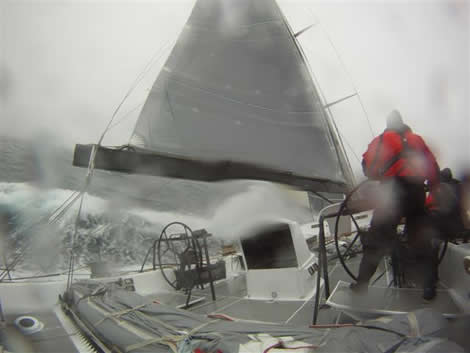
“So we'll pick a ‘lane’ tomorrow morning - with the breeze still nice and fresh. A few hours later we'll see how our choice panned out as we enter the light air. The weather models have a much harder time predicting the conditions in light winds compared to stronger winds (right now its blowing 23 knots) so there's a bit of voodoo and luck involved.”
And so this morning as she negotiates the ridge, Rambler is at her slowest so far this race, making just 7.7 knots. Due to the conditions crossing the top of the Azores high and the prospect of the ridge, so the leaders in the Transatlantic Race have now all slipped well south of the great circle.
Aside from Rambler 100, Ken Read's Puma continues to shine, just 34 miles astern of Rambler and closing - with the ridge orientated NW-SE, she is to the south and still in stronger breeze and making 15.7 knots. However this is merely delaying when she will have to tackle the ridge. In fact getting south is a smart move. The forecast has the wind going soft over the next 24 hours as the depression over the UK heads off into the North Sea and for the leaders this will see the northwesterly wind drop to 10-15 knots. So being further south for Puma should mean they can sail a hotter angle into the finish, but in the lighter conditions it looks unlikely she catch her big brother. Impressively Puma continues to lead under IRC.
In IRC 2, Chris Bull's Nigel King-skipperws Cookson 50 Jazz continues to lead both on the water and on handicap. In IRC 3 it is Huntington Sheldon's 65ft Reichel Pugh design Zaraffa that is ahead on the water but it is Uwe Lebens' Reichel Pugh 56 Scho-ka-kola that is ahead under IRC. In IRC 4, Carina, Rives Potts' McCurdy & Rhodes 48 footer, continues to lead both on the water and on handicap.
Meanwhile between the two Class 40s, the Ned Collier-Wakefield skippered Concise 2 has pulled a considerable lead, now up to 257 miles over Mike Hennessy's Dragon.
Puma's Ken Read reports:
Quite a moist race thus far. And, I mean moist in more than ways than one…rain, fog, waves crashing over the deck. It makes for a moist boat, and all of the cold adds to a problem with condensation dripping everywhere. Sound glamorous?
There are a few up sides though. First of all, we are hauling ass. We are already done with half of an Atlantic crossing and it seems like we just started. Tactically, there hasn’t been much in it so far, and it’s kind of a flat-out boat speed contest. With conditions that really suit our boat, there is already talk on board that maybe we should have done a couple easy things to improve our IRC rating...ahhh hindsight is a beautiful thing.
I forgot to introduce our special guest on board in my first note. Hakan Svensson, the CEO of BERG Propulsion, is with us on his first Atlantic crossing. He’s a very good guy, and a friend, not just a sponsor. It has been priceless to see his face at times during this trip. As we careen down the waves going 30 knots, and you see a wall of water about to crash over the deck, at first Hakan's eyes would get pretty big. Below, he is sleeping in a make-shift bunk, and when big waves hit, or major squealing or creaking noises came from the winches, he would pop his head up quickly and say "Is that normal?"
"I'm afraid it is," I would return, trying to give him a bit of peace with a friendly smile. I don't think he bought it at first. Now, after only a few days, he is turning into a speed junkie like the rest of us, wanting to hear those horrible noises as they mean we are going fast. He is becoming a Volvo sailor. Be careful Hakan!
A strange thing noticed by most of the crew moving the gear around down below was that Hakan’s personal gear bag was REALLY heavy. Nobody wanted to say anything, and we just let it go. A short while ago, we found out why. He presented the crew with a "half way there" gift of smoked sausages that are terrific. I'm not what you would call a smoked sausage guy. But, in contrast with freeze dried meals, anything tastes good, and those sausages certainly made the crew forget the fact that his gear weighed about 50 lbs!
The fast portion of the trip has less than 24 hours to go, then we jibe and head for England. No sun yet and not much in the forecast. Oh well. If it’s fast, don't complain.
Amory Ross reports from the STP65 Vanquish
Hello from the world of transoceanic crossers. Collectively I think we’re coming to grips with the reality of what’s going on here, crossing a really big ocean. It’s been about four full days since our start, five week days, and it is the longest I and most of this team have spent racing at sea before. I know, it’s really not much, but personally, for me—it means a great deal. It’s a major first step, a step I couldn’t have made without the Oakcliff All-American Offshore Team, and it says a lot for the importance of this program, that it continue on. Ocean racing is something that I have quickly fallen in love with and this opportunity, the experience we are currently living, others should be lucky enough to get. I sure hope to do my part to ensure they get it.
Like I said (pre-rant), life out here is normalizing. Routines are becoming routine, we’re all acclimating in different ways but everyone’s doing it. Some maybe aren’t getting what they wanted from it, taking the “next time I’ll fly!” approach, some of us definitely are getting what we wanted, some maybe still undecided. But that’s the beauty of ocean racing isn’t it? It means something different to everyone and you really have to get out here to see for yourself.
One thing all 16 of us have in common is the desire to get to England, and as fast as possible. Things are going well in that department, too. We currently sit in a pretty advantageous spot to the west of the fleet, better able to get weather before our competitors to the east; they are forced to react to our decisions, and only after we make them. The last 24 hours have been tricky but productive. We’re keeping the bow pointed at the “barn,” and sailing as fast as the sail and wind combination will allow. The high-pressure ridge in our way is slowly moving east, and in order to avoid running into it, we’ve been taking small hitches to the north (6 gybes last night), also in hopes of catching some of the weak low pushing off Newfoundland to our west. It’s a fine line we walk: if we go too far north we sail away from the “great circle” (shortest distance from Newport to the finish) and also risk sailing extra miles.
With the exception of Beau Geste, our competition has decided to dive south, the opposite strategy. Those boats, however, are far enough east that our own problematic ridge is well behind them. A new ridge of high-pressure and light winds is developing between their southerly position and the Lizard Point finish, though, so there is a lot that can happen in the next 48-72 hours.
The team is sailing hard and we’re all excited about what the next couple of days are going to bring on the racetrack. It’s uneasy being so alone up here, but we’re still confident in our call and the potential for huge gains from such significant separation.
Photos by Amory Ross/www.amoryross.com

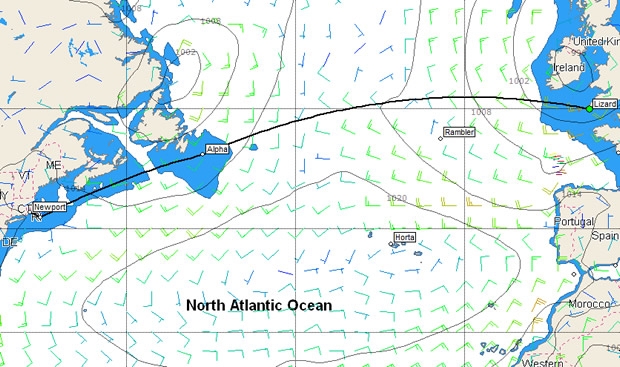
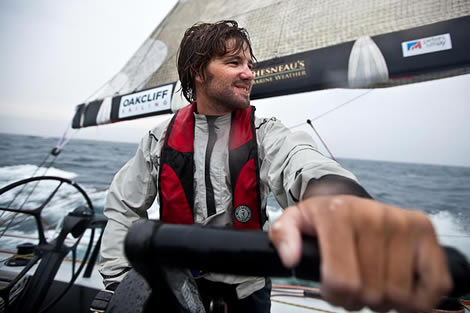
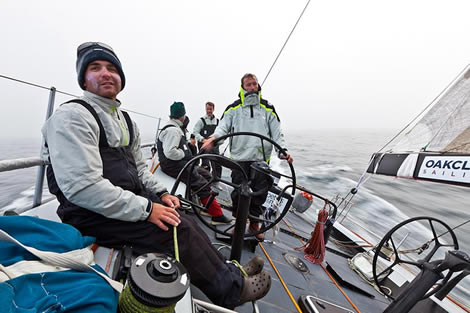
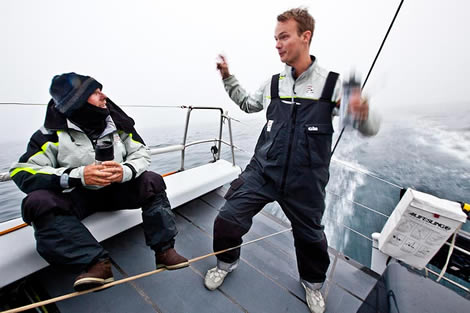
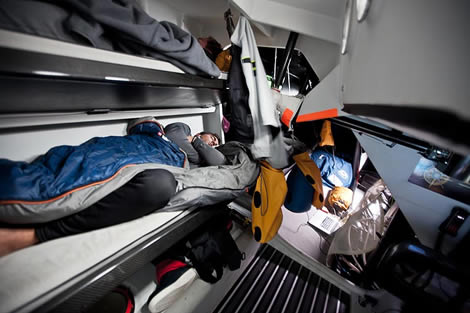









Latest Comments
Add a comment - Members log in